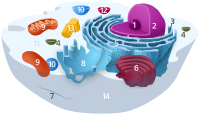
Photo from wikipedia
Biophysical stimuli presented to cells via microenvironmental properties (e.g., alignment and stiffness) or external forces have a significant impact on cell function and behavior. Recently, the cell nucleus has been… Click to show full abstract
Biophysical stimuli presented to cells via microenvironmental properties (e.g., alignment and stiffness) or external forces have a significant impact on cell function and behavior. Recently, the cell nucleus has been identified as a mechanosensitive organelle that contributes to the perception and response to mechanical stimuli. However, the specific mechanotransduction mechanisms that mediate these effects have not been clearly established. Here, we offer a comprehensive review of the evidence supporting (and refuting) three hypothetical nuclear mechanotransduction mechanisms: physical reorganization of chromatin, signaling at the nuclear envelope, and altered cytoskeletal structure/tension due to nuclear remodeling. Our goal is to provide a reference detailing the progress that has been made and the areas that still require investigation regarding the role of nuclear mechanotransduction in cell biology. Additionally, we will briefly discuss the role that mathematical models of cell mechanics can play in testing these hypotheses and in elucidating how biophysical stimulation of the nucleus drives changes in cell behavior. While force-induced alterations in signaling pathways involving lamina-associated polypeptides (LAPs) (e.g., emerin and histone deacetylase 3 (HDAC3)) and transcription factors (TFs) located at the nuclear envelope currently appear to be the most clearly supported mechanism of nuclear mechanotransduction, additional work is required to examine this process in detail and to more fully test alternative mechanisms. The combination of sophisticated experimental techniques and advanced mathematical models is necessary to enhance our understanding of the role of the nucleus in the mechanotransduction processes driving numerous critical cell functions.
Journal Title: Journal of biomechanical engineering
Year Published: 2017
Link to full text (if available)
Share on Social Media: Sign Up to like & get
recommendations!